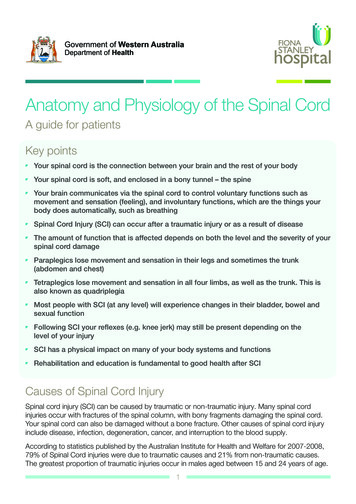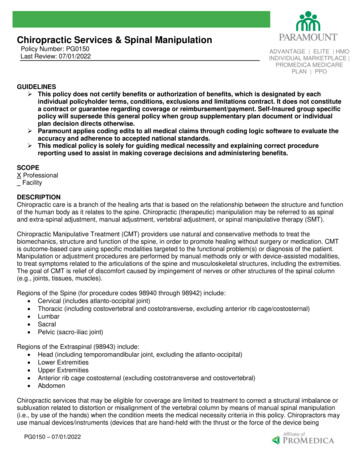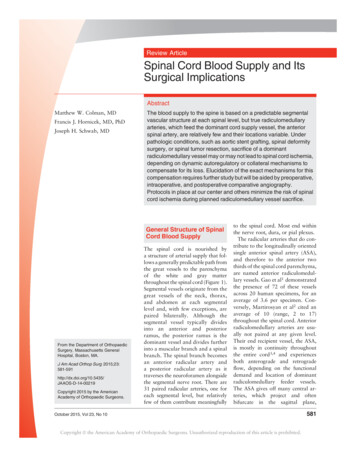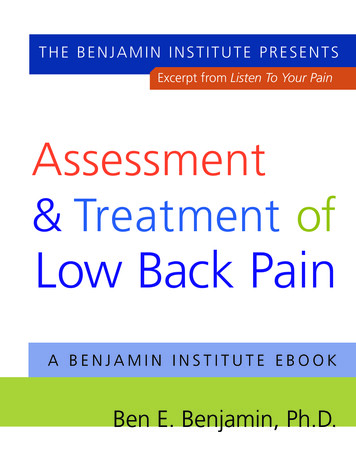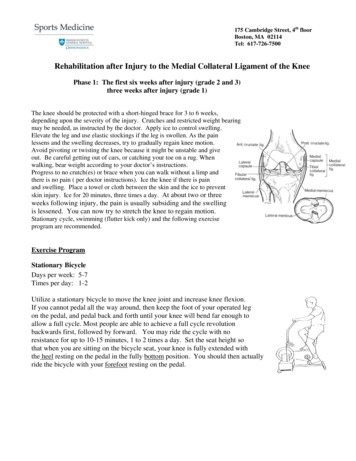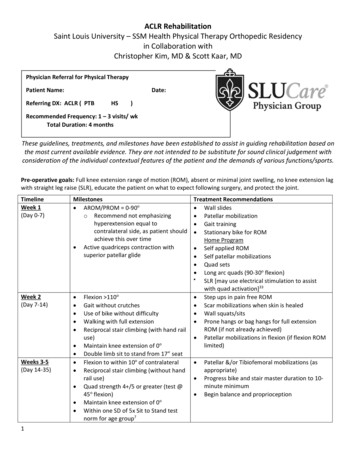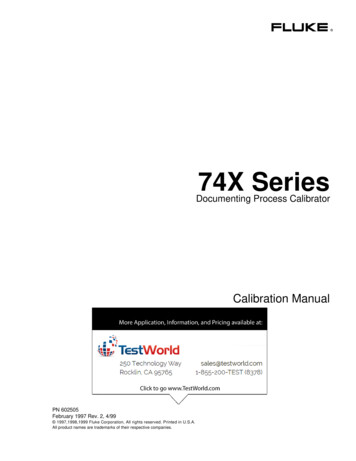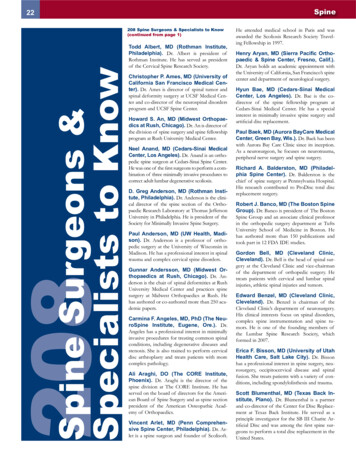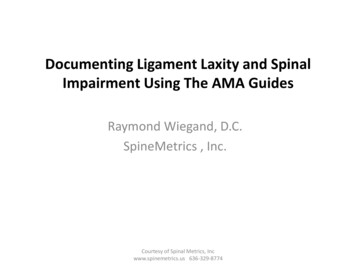
Transcription
Documenting Ligament Laxity and SpinalImpairment Using The AMA GuidesRaymond Wiegand, D.C.SpineMetrics , Inc.Courtesy of Spinal Metrics, Incwww.spinemetrics.us 636-329-8774
What is Ligament Laxity? Ligament laxity is a loss of functional stability between twoadjacent vertebra. It is described in the AMA Guides to the Evaluation ofPermanent Impairment, 3rd, 4th, 5th and 6th Editions It is an objective finding based not on opinion but onmathematical modeling. When identified it represents a 25-28% whole bodyimpairment.Courtesy of Spinal Metrics, Incwww.spinemetrics.us 636-329-8774
Is Ligament Laxity a Common Finding in SuddenImpact Injuries? In a sample of 588 patients involved in suddenimpact injuries 65% demonstrated one level ofratable impairment. 26% demonstrated two or more levels of ligamentinstability.Courtesy of Spinal Metrics, Incwww.spinemetrics.us 636-329-8774
What Does AOMSI Mean to the Patient(Alteration of Motion Segment Integrity) Ligament laxity identifies a patho-kinematic abnormality that alertsa doctor to use precautionary treatment procedures In some instances surgical intervention may be required to stabilizethe motion segment It informs the patient as to the current extent of injury and topotential future consequences It provides the treating doctor a biomechanically accurate diagnosisto create a long-term treatment plan to ensure stabilty When litigation is involved it objectively identifies injuryindependently of a positive or negative MRI. It creates theopportunity for fair and equitable settlements based uponinsurance carrier algorithms.Courtesy of Spinal Metrics, Incwww.spinemetrics.us 636-329-8774
Why is Functional Stability Important? The spine is a multi-component semi-rigid elastic structure– Semi-rigid is an engineering term describing the nature and propertiesof a single material or the behavior of a system of mixed materials. The spinal column is a system of mixed materials consisting ofalternating rigid vertebra and interconnected by elasticligaments. In a sequential and alternating combination, the vertebra andligaments transmit forces and limit motion while sharing andminimizing forces imposed on the system .Courtesy of Spinal Metrics, Incwww.spinemetrics.us 636-329-8774
The Anatomy of the Motion Segment The term motion segment is usedto define the smallest functionalunit of the spine. The motion segment includes anytwo adjacent vertebra and theinter-connecting ligaments The range and direction of eachvertebral motion unit is dictated bythe shape of the joint articulation The ligaments strength, elasticityand integrity confine joint motionto protect the biomechanicalstability of each vertebral unitCourtesy of Spinal Metrics, Incwww.spinemetrics.us 636-329-8774
Motion Segment Anatomy: Primary Structures The vertebra are inter-connectedby the strongest ligaments in thebody, the strongest are the discsThe primary role of the disc is totransfer forces and motionsthrough the spineThe disc attaches to the top andbottom of each vertebra across thewhole surface area of thevertebra. The disc never slipsThe disc provides continuity of thevertebra to function as acontinuous structureCourtesy of Spinal Metrics, Incwww.spinemetrics.us 636-329-8774
Surrounding Ligaments: Secondary Structures Each vertebra is surroundedby seven common ligaments1. Anterior longitudinal2. Posterior longitudinal3. Ligamenta flava4. Inter-spinous5. Supra-spinous6-7. Two (2) inter-transverse Any and every motion engagesmultiple ligaments into aresistive stateCourtesy of Spinal Metrics, Incwww.spinemetrics.us 636-329-8774
Ligamentum Flavum The ligamentumFlavum illustrates thecompleteness of anintact ligament systemto confine and restrictmotion from onevertebra to anotherCourtesy of Spinal Metrics, Incwww.spinemetrics.us 636-329-8774
Range of Motions Range of motions are determined by jointdesign and constrained by ligamentsAs a range of motion is increased in anydirection it engages multiple ligamentsthat when stretched, become more rigidand resistant. The resistive force isoriented to pull the vertebra back to itsoriginal neutral positionWhen a vertebra reaches an endpointrange of motion it is fully confined by thestrength and elasticity of the ligamentsCourtesy of Spinal Metrics, Incwww.spinemetrics.us 636-329-8774
Structural Design and Elastic Properties Likenedto a System of Springs and Levers The spinal joint is formed by thearticulation of two vertebra at the facetjoints. The facet acts as a central pivot. During flexion the vertebral bodiesapproximate while the posteriorelements (spinous processes) separate.The facet joints slides on one anotheras the vertebra pivots All motions of the vertebra areconfined by the inter-connectingligamentsCourtesy of Spinal Metrics, Incwww.spinemetrics.us 636-329-8774
Injury and Loss of Motion Segment Integrity:Flexion Injury During a sudden impact injury (when stopped)the vertebra suddenly accelerates ordecelerates in 10 msec. This suddenness overcomes the elastic strengthof the ligament. The ligament at first yields (i.e.)stretches to such an extent that it can notreturn to its original shape– This is due to internal disruption of theligament tissue (tertiary strain/sprain a.k.a.tearing) This is followed by complete structural orfunctional failure of the ligamentCourtesy of Spinal Metrics, Incwww.spinemetrics.us 636-329-8774
Ligament Injury Compromises the Integrity ofthe Motion Segment Depending on thedirection of the force/sand the ligament/sdamaged, the motionsegment is no longerrestrained within itsnormal ranges of motion Hypermobility in rotationand translation are thefirst consequencesfollowed by abnormalwear or degenerationwith aberrantneurological sequellaeither localized orradiatingCourtesy of Spinal Metrics, Incwww.spinemetrics.us 636-329-8774
Consequences of Ligament Laxity Irritation to the nerve from disc herniation iseasy to understand. Direct pressure orirritation to the nerve root.Ligament laxity is more subtle andcomplicated because it includes aberrantjoint motion and aberrant joint loading. Bothof which over time will produce irritation tothe innervating nervous tissue to all adjacenttissues (joint capsules, mechanoreceptors,etc )As normal joint alignment and loading iscompromised functional stenosis occursalong with structural degeneration.A viscous cycle of destabilization, andoverload continues driven by gravity andnormal activities.Courtesy of Spinal Metrics, Incwww.spinemetrics.us 636-329-8774
Measuring Method used to DetermineLigament Instability and Alteration of MotionSegment Integrity (AOMSI) The AMA Guides to the Evaluation of Permanent Impairment, 3rd, 4th ,5thand 6th editions have described the measurement method to determineligament instability (CPT 728.4) as far back as the 1980’s. The method involves measuring the rotation and translation of thevertebra from a cervical or lumbar radiograph (x-ray) in the flexion andextension positions. When the range of motion of adjacent motion segments differs by 11degrees or greater it is classified as AOMSI . This is a direct consequenceof a loss of ligament integrity. When translation of any motion segment exceeds 3.5 millimeters in thecervical region it is classified as AOMSI. When translation of any motion segment exceeds 4.5 millimeters in thelumbar regions it is classified as AOMSI.Courtesy of Spinal Metrics, Incwww.spinemetrics.us 636-329-8774
Procedure for Measuring AOMSI The four corners ofeach vertebra areidentified to calculatethe disc angle for eachmotion segment The range of motion ofeach motion segment iscalculated by taking thedifference of the flexionand extension discanglesCourtesy of Spinal Metrics, Incwww.spinemetrics.us 636-329-8774
Determining Impairment: Angular Analysis The spinal geometry anddisc angle range of motionare calculated anddisplayed in tabular andgraphical formats. Theresults are compared tothe threshold values asdefined by the GUIDES.Courtesy of Spinal Metrics, Incwww.spinemetrics.us 636-329-8774
Measuring the Difference of Range of Motion1. The range of motion is determined for each motion segment2. The difference of each adjacent segment range of motion iscalculated.3. In this example the difference of C5 to C6 is 15.8⁰. The impairmentthreshold of 11⁰ is exceeded and the patient qualifies for a 25%whole body impairmentROM DIFF IMPAIRF/E 15.8 **C7-5.57.4Courtesy of Spinal Metrics, Incwww.spinemetrics.us 636-329-8774
Determining Impairment: Translation AnalysisThe translation (front toback movement) of eachvertebra is calculated anddisplayed. In the cervicalregion, translation equalto or greater than 3.5 mmqualifies for a 25% wholebody impairment .In the lumbar regiontranslation equal to orgreater than 4.5 mmqualifies for a 25% wholebody impairment.Courtesy of Spinal Metrics, Incwww.spinemetrics.us 636-329-8774
When is testing for AOMSI Appropriate ANY patient involved in a sudden impact injury should betested for AOMSI This includes but not limited to– Automotive accidents of any kind at any impact velocity– Sports injuries where concussion is suspect– Forceful falls– Forceful acceleration or deceleration incidences whereneck or low back pain are involved Clinical Criteria: Loss of range of motion and pain assequella to traumaCourtesy of Spinal Metrics, Incwww.spinemetrics.us 636-329-8774
Where and How do I get AOMSI Testing The patient’s doctor can order the necessary x-raystudies The doctor can contact Spine Metrics, Inc. tocomplete the testing Spine Metrics can be contacted at 636-329-8774 or www.spinemetrics.us email smsubmitfiles@gmail.com Ask for Dr. Raymond WiegandCourtesy of Spinal Metrics, Incwww.spinemetrics.us 636-329-8774
It is described in the AMA Guides to the Evaluation of Permanent Impairment, 3rd, 4th, 5th and 6th Editions It is an objective finding based not on opinion but on mathematical modeling. When identified it represents a 25-28% whole body impairment. Courtesy of Spinal Metrics, Inc www.spinemetrics.us 636-329-8774

